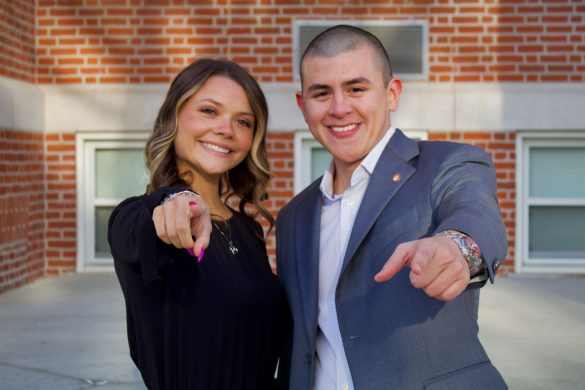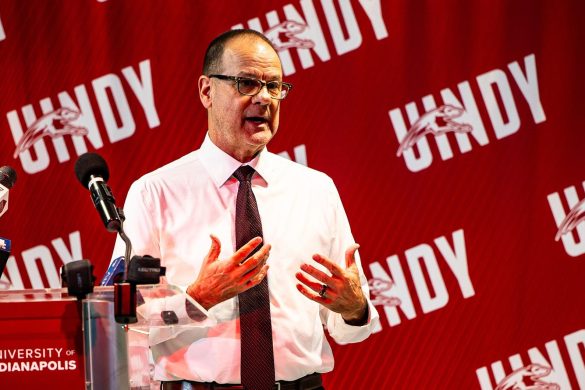IndyGo is creating the first rapid transit system for the city of Indianapolis, the Red Line as part of an initiative to increase transportation services in Marion County by 70 percent. The Red Line will run from Broad Ripple, through downtown, to the University of Indianapolis through the most densely populated corridor in the city.
The Red Line will run 20 hours a day, 5:00 a.m. to 1:00 a.m., with buses arriving every 10 minutes. Director of Public Relations for IndyGo Lauren Day said many of the current routes do not run to the evening and riders often have to wait 30-60 minutes for their bus to come. The Red Line stations will also differ from normal bus stops. The stations will feature elevated platforms, covered to protect riders from the wind and sun, that feature real time information. The vehicles themselves will be fully electric and offer WiFi.
Although the Red Line will not be open until late summer or early fall of 2019, construction has begun around Indianapolis, including near UIndy. According to Associate Vice President and Special Advisor to the President for External Relations Corey Wilson, after IndyGo decided to have a stop near UIndy on Shelby Street, the university worked closely with them to make sure the station would be easily accessible for students and the community. Wilson said having the Red Line stop at UIndy further connects the university to the city of Indianapolis.
“It offers an opportunity for our students to explore unknown parts of the city of Indianapolis, which I think is beneficial as students consider employment and where they’ll live after they graduate,” Wilson said. “I also think it provides an opportunity for the broader Indianapolis community to visit our campus for various performances, lectures, et cetera, in a fast and convenient method.”
Day said IndyGo is committed to providing options for getting around so that everybody can live the best life that they can. Students will have more opportunities to explore areas of the city, jobs and many new activities.
“If you think about what job opportunities you have available to you or what education opportunities you have available to you, how long it takes you to get there and if you have a safe and reliable ride home, overtime, if not just immediately, is going to impact that decision” Day said. “So when transportation works, when rapid transit exists, when frequent service exists, your options constantly grow. They become ever larger.”
The Red Line is not the only improvement happening to the Indianapolis transit system. IndyGo is also improving the local bus routes, which are the routes most people are familiar with now. Currently, to transfer to a bus going a different direction, most riders have to go to the transit center downtown. According to Day, the most effective transit systems are a grid network that allow riders to transfer at multiple points. IndyGo plans to implement a grid system with buses that arrive about every 15 minutes, at the same time the Red Line opens.
Day said IndyGo also plans to update their fare technology, which currently only allows riders to pay cash on the bus or buy a pass at the transit center or online. She said they are looking into a system that allows people to use their phone or an app on their phone to pay so that it will be more user friendly.
Two more rapid transit lines will also be added to the IndyGo network. The Purple Line, expected in 2020, will follow what is currently Route 39 and travel from the transit center, North on Meridian Street and East on 38th St., then North on Post Road to the Ivy Tech campus in Lawrence. The Blue Line, expected in 2022, will follow what is currently Route 8 and travel on Washington Street from the East side of Marion County and to the Indianapolis International Airport.
The major construction around UIndy is expected to wrap up sometime this fall. Currently Day said, they are focusing on civil work, such as improving the sidewalks, ramps, drainage systems and pedestrian crossings, which are necessary when implementing a new station. Next month, she said, the foundation for the station will be laid. The station, however, will not be placed until closer to the time the Red Line opens and is assembled elsewhere. Electrical work inside the station and road striping will also have to be done before the Red Line opens. Day said the transportation improvements will make it easier for UIndy students to get around Indianapolis.
“You all will be able to hop on at a station right there on campus,” Day said, “And if you want to be in Fountain Square, if you want to be downtown, if you want to be all the way in Broad Ripple, it will just be a whole lot quicker to get you throughout Indianapolis.”
Wilson said another benefit to the Red Line is that it is very economical, especially compared to Uber. According to Wilson, riders will be able to go from UIndy to Broad Ripple for $1.75.
“You’ll get there faster obviously going in an Uber, but this will be a fun way to see different parts of the city,” Wilson said. “And who knows you may plan to go to one location but want to jump off and see and explore around and get back on.”
For those interested in the construction process, an interactive map can be found online at indygored.com. The website also feature tools that explain more about the project, phases, stations and what riders can expect when the Red Line opens.








